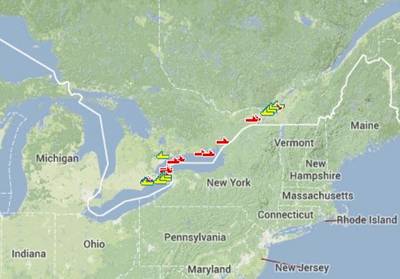St. Lawrence Seaway Overall Tonnage Down for 2013
The St. Lawrence Seaway reported that year-to-date total cargo shipments for the period March 22-September 30 were 23 million metric tons. While this number is down 11% over the same period in 2012, U.S. ports continue to beat the odds with increased tonnage in several cargo categories.
"At least a dozen ships from Europe unloaded steel products at the ports of Cleveland, Milwaukee, Burns Harbor and Detroit over the past month; a clear sign that the end of the navigation season is approaching and shippers are working diligently to get products out of the mills and into the Seaway System before the end of the year," said Rebecca Spruill, Director Trade Development for the Saint Lawrence Seaway Development Corporation. "Although overall cargo tonnage is down, September provided many positive signs that the next three months will be extremely busy for our ports and terminal operators in the Great Lakes-Seaway System."
In September, the Port of Cleveland moved 66,812 metric tons of general cargo, almost doubling the amount moved in August, and more than doubling the amount moved in September of 2012.
"This is the most cargo that we have moved in any one month since November 2006," said David S. Gutheil, Vice President of Maritime & Logistics. "The increase in cargo can be attributed to a high demand for imported steel by local manufacturers and processors in addition to machinery unloaded by our heavy lift crane destined for Pennsylvania. The Port, and our terminal operator, Federal Marine Terminals, work together to compete globally as the first major U.S. port on the Great Lakes; our multi-modal capabilities allow us to provide customers all-water access to and from international markets."
The Port of Indiana-Burns Harbor saw a 16% increase in total tonnage through the month of September, putting it on pace for its highest annual total in over six years.
"Steel and steel-related byproducts continue to drive strong shipment numbers through the port in conjunction with a steady increase in other bulk commodities such as coal, fertilizer and limestone," said Port Director, Rick Heimann.
"Looking ahead, we expect this trend to continue next month as we already have on the books a shipment of distillery tanks from Germany bound for a brewery expansion in Chicago."
For the past three years, Midwest Energy Resources Company (MERC) has been exporting coal from Superior, Wisconsin, to Western Europe via the Great Lakes-Seaway System. On September 3 they welcomed Canada Steamship Lines' new vessel, Baie Comeau, to its terminal.
"We utilize a transshipment facility in Quebec City to take full advantage of this northern marine corridor," said Fred Shusterich, MERC president. "In our trade, we are excited about the advent of these new Canadian ships - the high caliber of these state-of-the-art vessels equates to increased efficiency and lower costs for our customers, all of which bodes well for continued export business."
MERC has been able to capitalize on the increased demand for U.S. low-sulfur coal in new international markets, seeing growth in exports to the Netherlands and Spain. "We are pleased to have CSL as a partner with us in the export business," added Shusterich.
In addition to the uptick in general cargo traffic at the ports, U.S. grain remained a bright spot for the month. Nearly 700,000 metric tons of U.S. grain moved through the System, representing a 27% increase year-to-date over 2012. Overall, cargo categories were down. As noted above, steel is driving tonnage for some U.S. ports, but iron ore and coal shipments remained down in September by 18 and 2% respectively.
Within the dry bulk category, scrap metal was up 22%. The liquid bulk category posted an 8.6% jump over the same time in 2012.














